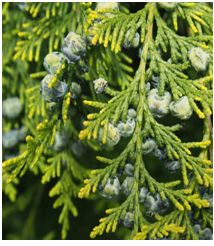
Botnical Name – Thuja orientalis L.
Common Name – vidhya
Classification –
Kingdom – Plantae
Division – Magnoliophyta
Class - Magnoliopsida
Order – Pinales
Family – Cupressaceae
Genus –Thuja
Species – orientalis
Characteristics Of Family Cupresssaceae –
This is also called Cypress and Conifer family. The are distinguished in being monoecios or deioecious trees or shrubs with spiral , decussate , or whorled deltoid –subulate, linear , or acicular leaves .
Habitat – Hilly area
Distribition – India – Anurachal Pradesh , Assam , Eastern and western Himalayas, Madhya Pradesh.
World distribution - Bhutan , Japan , China , Myanmar , Pakistan , Taiwan , North korea , Russia .
Status – Least concern
Plant description -
Monoecious evergreen trees to 20 m tall and 100 cm . Bark red-brown to light grey-brown, thin, flaking in long strips.
Leaves decussate, 4-ranked, scalelike, base decurrent, 1-3 mm long, apex bluntly pointed, with an abaxial resin gland, dimorphic along branchlets; lateral leaves overlapping facial ones, boat-shaped, ridged, apex slightly incurved, without conspicuous, white stomatal bands abaxially but with a median groove.
Uses
Thuja orientalis is traditionally used in herbal medicine as an expectorant.
Thuja has been known to help treat and heal a number of skin condition such as psoriasis , warts, eczema and other common issues.
Thuja leaves contain an oil called thujone , which may cause side effect or have negative interaction with other drugs or herbs.